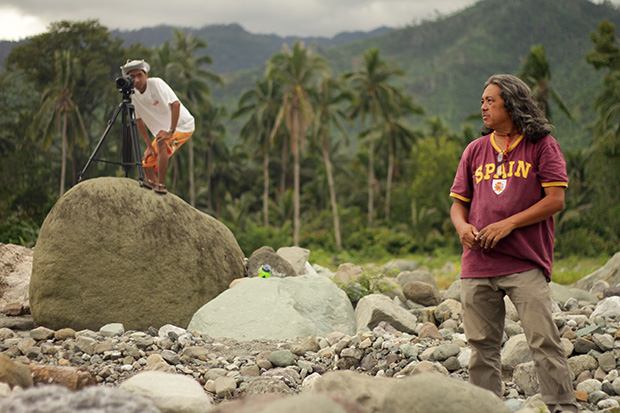For the longest time, the award-winning Mindanawon filmmaker, Arnel Mardoquio, had been inviting me to visit him and the members of his team while they were shooting a film. I had long wanted to respond favorably to the invitation as I was curious how he directs his film during a location shoot.
Finally, the opportunity came and everything conspired to make it possible for me to make it to the chosen location for a film he hopes will be shown during the Cinema One Film Festival in November 2013. It was only a one-day visit – from late morning of 28 July to noon time the following day — but it was more than enough to satisfy my curiosity.
 Director Arnel Mardoquio at work. Photo Courtesy of The Riddles of my Homecoming Crew
Director Arnel Mardoquio at work. Photo Courtesy of The Riddles of my Homecoming Crew
Immediately after his last film – Ang Paglalakbay ng mga Bituin sa Dilm ng Gabi – won Best Film at the Urian Awards this year, Mardoquio and his team trooped to Barangay Andap, New Bataan for the first part of shooting his latest film.
Unlike his previous four films, the film-in-progress – Ang mga Tigmo sa akong Pagbalik (The Riddles of my Homecoming) – will veer away from the standard Mardoquio filmography. This time he explores the artistic field of filmmakers like Terrence Malick (Badlands, The Thin Red Line and The Tree of Life) where the screenplay uses very limited spoken dialogue.
The film’s narrative follows a mythical trajectory and explores the domains of dreams. The film language is captured in sharp symbolic images thus necessitating a shift in terms of the over-all design of the film. Practically the film’s locale is in the outdoors and the landscapes through which the actors traverse in various cinematic motions needed out-of-this world vistas.
Which is why Mardoquio and all the members of his team decided to shoot in Andap, specifically where the Mayo River flows down and becomes the Kalgawan River flowing towards the Compostela Valley. Before Pablo’s wrath hit the mountain range surrounding New Bataan which resulted in landslides that pushed boulders, stones and mud down the path of the river and its banks, Andap was a peaceful barangay of 1,700 households with a total population of 7,594 people who were mostly Mandaya.
In the past, the Mayo River gently flowed from the mountain towards New Bataan. Even in the worst flood scenario, the waters overflowed the banks but did not cause massive dislocation.
But on that tragic day of 4 December 2012 – a day that will be remembered for generations to come across ComVal – the deluge swamped through the cleavage between the two parallel range of hills and mountains sweeping whatever stood on its way – roads, houses, fields of cash crops, coconut trees and the inhabitants. The yangkamatay (drowned) and the yangkatabug (missing) numbered close to 2,000; until today, the LGU has not been able to accurately count those who vanished with the flood.
After Pablo, the landscape of Andap radically changed. Six months later, the surreal landscape is a sight to behold.
Where the deluge cascaded, nothing stands anymore; it looks like a desert constituted with all sizes of stones. If one stands on a huge boulder and look towards the south, one sees the breath-taking view of the Compostela Valley below. Today, the Mayor River is back to its original size and flows down its usual route. There are wildflowers – especially orange marigolds – that have grown where there is a bit of soil and are in full blown; one thinks of them as floral offerings to the departed.
This was the perfect location site for Mardoquio’s latest film as it needed this kind of setting; Andap serendipitously provided him with what he needed. Through the permission granted by the Local Government Unit, Mardoquio’s team was allowed to shoot the film here. The sacredness of the place, its haunting images heightened by the memories of the tragedy and how this space has taken on deep symbolic meanings are what drew Mardoquio to this setting. All the members of the film crew made sure to acknowledge the location’s sacredness and meaning. Throughout the time I spent with them, I could observe that they made sure to tread gently across this landscape.
I admired the courage of the film actors and crew. On the night of 28 July, the sky threatened to give way to torrential rains. Some of the people of the village warned them that a flood could take place in the dead of night. Despite the risks, the shooting continued till almost the wee hours of the morning. Fortunately, there were no heavy downpours during the filming.
As with other indie film crews, Mardoquio’s is lean and efficient. Ditsi Carolino – the award-winning documentary filmmaker (Minsan Lang Sila Bata, Riles, Bunso) who visited the set – was struck at how hard-working everyone was. “I thought I and my small crew are the hardest working filmmakers; it turns out we cannot hold a candle to Mardoquio’s crew! Their call is early in the morning and they wrap up late at night, with very little time to take a break!”
Mardoquio’s team is composed of Yam Palma, assistant Director; Arnel Barbarona (Director of Photography), Macario Robert and Bordie Carillo (also doing Photography), Jerome Dulin and Lou Avila (sound), Jazmin Aller (continuity), Jeffrey delos Santos (Production Manager), Buggy Amplayo (Art Director), Rallon Monsanto, Rene Paradiro and Alvin Aliong (various tasks). The members of the cast are Perry Dizon, Fe Gingging Hyde, Madeleine Garcia, Jeff Sabayle, Cristy Lim and Jillian Barbarona.
As in theatre, a few of them play more than one role. There are no divas among the actors; all take on other tasks when they are not acting in front of the camera.
With Mardoquio asserting a strong leadership in the making of this film as well having earned his members’ trust and confidence, all constantly manifest a deep subservience to “Direk.” They follow all his orders although at times they also make suggestions; even when Derek shows impatience and muted anger when some things are not done well, no one walks out, no one complains. There is a very strong sense of collaboration and mutual support. A hierarchical structure hardly exists. While eventually Mardoquio will be recognized as this film’s maker, the fact is that an indie film is made not just by one filmmaker but everyone who contributes to its completion.
[This piece was first published in the September 16, 2013 issue of OUR Mindanao, the weekly newsmagazine of MindaNews. Bro. Karl Gaspar. CSsR, is the head of the Redemptorist Center for Social and Ecological Concerns and the Alfonsian Lay Formation Institute. He teaches at the St. Alphonsus Theological and Mission Institute (SATMI) and the Ateneo de Davao University’s Institute of Anthropology. He writes a column – A Sojourners’ View – for MindaViews, the opinion section of MindaNews].
